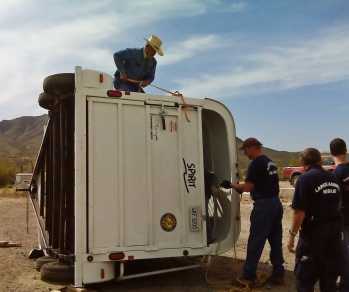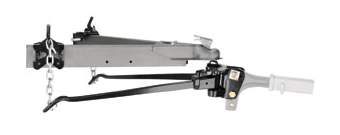|
By Jerry Tardif
 Photo Courtesy of Arizona Equine Rescue Org, Inc.
Photo Courtesy of Arizona Equine Rescue Org, Inc.
|
Trailering at any time of year requires additional precautions compared with driving without a trailer.
But in autumn, it takes on extra significance because we start to see more wind compared to the summer months.
The wind often will have several effects on trailering your horse.
It will have an effect on the handling of your trailer while underway and your horse will be more spooky than usual because of the sound and feeling of the wind itself.
Combined, you have a recipe for additional problems that you want to avoid.
|
Let's first discuss the effect of wind on your horse.
Horses are usually most bothered by wind at the onset of autumn when the winds first kick up.
That's because the summer has usually been calm and it seems to horses that the world comes alive when the wind starts to blow.
Between the sound of the wind and the movement all around them from leaves and blowing debris, horses can initially spook and you'll typically notice them being uneasy the first few days of windier conditions.
After that, they'll usually grow accustomed to it and simmer down.
We have another article in which you can learn more about Horses and Wind.
The second and primary focus of this article is the effect of wind on the trailer itself.
Because of the height of a typical horse, all trailers are much higher than a car and even higher than most SUVs and pickup trucks used to pull most trailers.
A typical horse trailer will usually have an inside height of seven feet.
Trailers for draft horses will be still higher plus the height of the trailer bottom above the ground.
As a result, the effect of the wind blowing against the side of a trailer is very significant and can cause additional sway and movement of the trailer while underway.
The effect is worse when the trailer is empty, but even when fully loaded with horses, you'll feel the tugging and pulling by the trailer as you drive.
You can reduce sway in several ways, but the most effective way is also the cheapest — slow down.
By doing so, you significantly reduce the chances that you'll lose control of your trailer and tow vehicle.
If you have a fifth-wheel or gooseneck trailer, both of these systems are somewhat more stable because they place the towing load at mid-body in the truck's bed.
If you have a bumper-pull trailer, the trailer is instead attached to the back of your tow vehicle and has more leverage to turn it.
You can make it more stable by using a weight-distribution system (see photo below).
Such a system distributes the load more evenly to all tow vehicle and trailer axles.
It also reduces trailer sway.
Use of an anti-sway bar will further dampen, and therefore reduce trailer sway.
But be careful; you should never back a trailer with the sway bar in place.
If you do, you can damage it.
It's quick and easy to remove the bar, but it does require that you exit your vehicle to do so.
 Weight Distribution System
Weight Distribution System
|
A much bigger concern affected by wind is trailering on wet roads.
Friction is already significantly reduced for any vehicle when riding on wet pavement.
When the wind is up and a trailer is attached, it can be far worse.
Consider this scenario:
- The trailer provides a large flat profile with which to "catch" the wind;
- The horses are moving uneasily in the trailer and shifting their weight because of the sound of the wind and items being blown about;
- The roads are slippery because they're wet.
In heavy rain, they may also have a thick film of water on them which will promote hydroplaning.
If traveling too fast, which might only be the speed limit or slightly below it, the wind can push the trailer and cause a complete loss-of-control accident.
When there's wind, you should significantly slow down when trailering.
If the roads are also wet, you must slow down much more.
On such days, traveling at slow speeds, such as 30 -35 MPH is not overly cautious — it's wise and a lot safer for you, your horses, your passengers, and anyone else sharing the road with you.
If you have an open stock trailer, even the force of the raindrops hitting your horses while underway at 30 MPH can make them sore.
If you've ever put your hand outside a car window while driving in the rain, you know how much those raindrops can hurt when they hit you even at slower speeds — it's no different for our horses.
The openings of stock trailers should be closed with some visible, but unbreakable window material, such as acrylic sheeting (e.g. plexiglass) or some such, when trailing in cold weather or rain.
The wind shouldn't stop you from moving your horses and enjoying the cooler and beautifully clear days of autumn.
But live to enjoy them many more days by taking reasonable precautions as the winds begin to blow again, especially when the roads are also wet or slippery from any cause.
Besides being an avid trail rider, Jerry Tardif is a technology consultant and a horse and nature photographer in SE Connecticut — see his work at: www.jerrytardif.com.
He is also co-founder and President of QueryHorse.
Back to Article Index
|